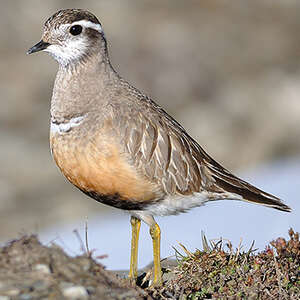Eurasian Dotterel
Eudromias morinellus - Pluvier guignard
Identification
The Eurasian Dotterel is one of the few species where the female is both larger and more colourful than the male. In nuptial plumage, it cannot be confused thanks to its distinct white eyebrow, its grey and brown underparts and especially its narrow white breast band. In its nuptial plumage, it is also quite recognisable due to its well-marked upperparts resembling a bit the Variable Plover. Confusion is nevertheless possible with the Asian Plover or the Golden Plover. The shorter beak, paler legs (yellowish) and wings that seem too short for its plump body are criteria that make it possible to differentiate it.
Subspecific information monotypic species
Foreign names
- Pluvier guignard,
- Chorlito carambolo,
- borrelho-ruivo,
- Mornellregenpfeifer,
- havasi lile,
- Morinelplevier,
- Piviere tortolino,
- fjällpipare,
- Boltit,
- kulík vrchovský,
- kulík hnědý,
- Pomeransfugl,
- keräkurmitsa,
- corriol pit-roig,
- Fjalllóa,
- mornel,
- morinella tārtiņš,
- dular,
- Хрустан,
- コバシチドリ,
- 小嘴鸻,
- fjällpipare,
- 小嘴鴴,
Voice song and call
Habitat
During breeding, the Eurasian Dotterel prefers flat areas at the top of mountainous regions, where there is an association of rocky blocks and low, grassy and mossy vegetation.
Behaviour character trait
The Eurasian Dotterel is a great migrant, wintering in the semi-arid zone spanning from Morocco to Iran.
Siberian birds must thus make a journey of more than 10,000 kilometres before reaching their winter quarters. Northern European-nesting Eurasian Dotterels leave their nesting sites in September or October, whereas those from Siberia depart in July; males and juveniles take their leave roughly two weeks after females. In France, the Eurasian Dotterel is only observed in small numbers during migration periods (but a few pairs nest more or less regularly in the Pyrenees). The passage begins around mid-August, peaks at the end of the same month and in the first half of September, then decreases until November. Spring observations are very rare. One must look for them on mountain lawns and in ploughed fields, short pastures or wasteland; their identification is sometimes delicate as they do not always present the typical nuptial plumage; the species has occasionally nested in the Vosges and the Pyrenees.Flight
Dietfeeding habits
The Eurasian Dotterel eats insects, particularly small beetles and flies which it finds on rocky ground or among vegetation. It also captures spiders, earthworms, small snails and some vegetables. It feeds mostly at dawn and night, often some distance away from its nesting territory. In the fashion of the Dotterel, it trots, then stops still before bending down to capture a small prey.
Reproduction nesting
At the Eurasian Dotterel, the roles are reversed during the mating display. The female, larger and more colourful, pursues a male, calling out and often spreading its wings before letting them fall back.
It quickly isolates the male from its small group. At the nesting site, chosen to offer an unobstructed view, the male and female take turns digging a shallow hollow. The bird digging up throws up grass and moss which its partner then places in the cavity. When the female has laid its three eggs, it leaves the male and joins other females. The male incubates for four weeks and is difficult to spot due to his camouflaged plumage. The eggs bear dark spots to remain unnoticed. The chicks have soft yet heavily speckled down. They soon know how to run and feed themselves, watched over by the male. As a predator approaches, the male can pretend to be injured, hopping as if his wings were broken. This way he draws the predator away from the nest or young.Threats - protection
IUCN conservation status
concern
in the Wild
threatened
evaluated
The Eurasian Dotterel is mainly threatened due to the disappearance of its habitat due to winter tourism (ski resorts and lifts, roads, urbanisations) and illegal hunting.
Sources of information
- IOC World Bird List (v15.1), Gill, F and D Donsker (Eds). 2025-12-07.
Other sources of interest
 Specification sheet created on
28/10/2023 by Didier Collin with help of Daniel Le-Dantec and Georges Olioso
Specification sheet created on
28/10/2023 by Didier Collin with help of Daniel Le-Dantec and Georges OliosoTranslation by AI Oiseaux.net
© 1996-2026 Oiseaux.net
- Accipitriformes
- Aegotheliformes
- Anseriformes
- Apodiformes
- Apterygiformes
- Bucerotiformes
- Caprimulgiformes
- Cariamiformes
- Casuariiformes
- Charadriiformes
- Ciconiiformes
- Coliiformes
- Columbiformes
- Coraciiformes
- Cuculiformes
- Eurypygiformes
- Falconiformes
- Galliformes
- Gaviiformes
- Gruiformes
- Leptosomiformes
- Mesitornithiformes
- Musophagiformes
- Nyctibiiformes
- Opisthocomiformes
- Otidiformes
- Passeriformes
- Pelecaniformes
- Phaethontiformes
- Phoenicopteriformes
- Piciformes
- Podargiformes
- Podicipediformes
- Procellariiformes
- Psittaciformes
- Pterocliformes
- Rheiformes
- Sphenisciformes
- Steatornithiformes
- Strigiformes
- Struthioniformes
- Suliformes
- Tinamiformes
- Trogoniformes































